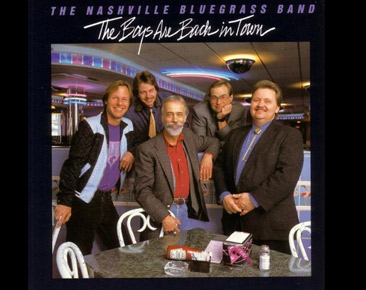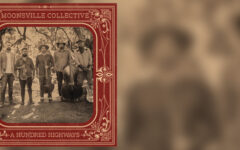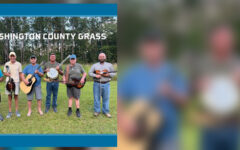
 It has long been a practice in bluegrass music to give country songs a grassy feel. One band who did this as well as anyone had the privilege of seeing one of their original tunes on the receiving end of a country recording. Patty Loveless’ 2001 bluegrass-influenced album Mountain Soul opened up with The Boys Are Back In Town, the title track from a 1990 album by The Nashville Bluegrass Band (NBB).
It has long been a practice in bluegrass music to give country songs a grassy feel. One band who did this as well as anyone had the privilege of seeing one of their original tunes on the receiving end of a country recording. Patty Loveless’ 2001 bluegrass-influenced album Mountain Soul opened up with The Boys Are Back In Town, the title track from a 1990 album by The Nashville Bluegrass Band (NBB).
The Boys Are Back In Town followed NBB’s collaboration effort with Peter Rowan, New Moon Rising. That album was the beginning of a sixteen-year stretch where every new album NBB released (seven in all) was nominated for a Grammy, two of them being winners. WOW! When a resume like that is posted, that band definitely deserves an Album of the Week accolade!
The Boys Are Back In Town is one of my favorite NBB albums because of the sheer variety offered to the listener. I believe this is the reason they were one of the most dominant bluegrass bands throughout the nineties.
At the time this record was released, the band consisted of original members Pat Enright and Alan O’Bryant matched with Gene Libbea on bass, fiddle master, Stuart Duncan, and bluegrass mando legend, Roland White. This all-star lineup remained intact for the bulk of NBB’s success.
There’s a reason that Patty Loveless included this album’s title track on Mountain Soul, because it is a KILLER tune! Co-written by Alan O’Bryant and Stuart Duncan along with Don Humphries, The Boys Are Back In Town is a catchy little number that paints quite a picture. Heavily driven by Duncan’s fiddle, this is one you will want to listen to over and over again.
Stephen Foster is one of the greatest American songwriters of all time. He penned such American favorites as Oh! Susanna, Old Folks At Home, and My Old Kentucky Home. Foster’s standard Hard Times (Come Again No More) has been covered by a wide variety of artists including Johnny Cash, The Isaacs, Bob Dylan, and eastmountainsouth. This should serve as a testament to the timelessness of Foster’s songwriting. Of all the versions, I like NBB’s version here the best.
Foster passed away in 1864, so there is no recording of his rendition, but I believe NBB’s would please him. The simplicity of this arrangement leaves plenty of room for the voices to shine. The quartet of Enright, O’Bryant, Libbea, and Duncan is magical. Match this with the old-timey sound of O’Bryant’s banjo on the cut and Stuart Duncan’s lonesome fiddle, this recording sounds straight from the Civil War. NBB’s Hard Times is a highlight on this album.
The Ghost Of Eli Renfro is afire example of a bluegrass murder/ghost song, and here Alan O’Bryant knocks it out of the park. Del McCoury turned this song into a standard when he recorded it with the Dixie Pals. What makes NBB’s version unique is the difference in styles between Del and O’Bryant’s singing. Where Del is more of a high lonesome Monroe-esque singer, I find O’Bryant more of a bluesy bluegrass singer, cut from the same cloth of Larry Sparks. This gives the song quite a different feel from The Dixie Pals’ take. If you have not heard NBB’s version, make sure you give them a chance to let Eli Renfro kill his wife with “a long, sharp Bowie knife.”
SPOLIER ALERT: If you couldn’t tell from that quote, The Ghost of Eli Renfro isn’t exactly for the light of heart. But then again, what murder ballad is?
As I mentioned earlier, NBB is among the best at transforming country standards into bluegrass favorites. One example of this is their cut of Hank Williams’, Weary Blues From Waitin’. Pat Enright conveys the song’s weary sentiment on the verses, and when he stretches the lyrics, it feels as if he is stretching your heartsrings in the process. However, the real magic in this song comes on the chorus when Enright and O’Bryant’s duet takes over.
Nashville Bluegrass Band’s vocal prowess and strong instrumental skills, made it almost impossible for them NOT to be nominated for seven Grammys. Throughout this album, the bass/mandolin combo of Gene Libbea and Roland White creates a rhythmic pulse that pushes the music right along. Add in O’Bryant’s bluesy banjo and Enright’s traditional guitar style, you have a deadly accurate combination.
Oh yeah, “They had this fiddle player that was okay too,” said the master of understatement. Stuart Duncan is one of the greatest fiddle players in the business. Period. I view his fiddle work as I do Jerry Douglas’ dobro playing: whatever he chooses to play fits the moment perfectly. On NBB’s unique brand of bluegrass, the rock music of Elvis Cotello, or the classical-influenced Goat Rodeo Sessions with Yo Yo Ma, Edgar Meyer, and Chris Thile, Duncan’s musical choices fit perfectly and demand attention, without overpowering his partners. His mind-numbing ability earned him eight International Bluegrass Music Awards for Fiddle Player of the Year.
Let me say thatI am a huge Johnny Cash fan. I may have mentioned it before, but I’ll say it again: The Man In Black is my favorite artist of all time. Keeping that in mind, it is only natural that seeing NBB doing a version of Big River piqued my interest when I first discovered this album. It quickly became one of my favorite Cash covers of all time.
Big River strikes me as one of Cash’s most under-appreciated tunes. Everyone focuses on the mega-hits such as I Walk The Line and Folsom Prison Blues when considering him as a songwriter. I think that several of the songs which don’t appear on 16 Greatest Hits serve to best showcase his songwriting genius. (Every time I hear the line “I met her accidentally in St. Paul, Minnesota,” I go nuts!)
Pat Enright’s vocal work on Big River is strong throughout. His sky-high tenor is lightyears different from Cash’s signature baritone, but it fits this song perfectly; the power in his singing is electric. The instrumental work on this track is also quite different from Cash’s classic boom-chicka-boom sound. I love how NBB gives the song a Dixieland jazz band feel. Thank O’Bryant’s bouncy banjo, Duncan’s jazzy fiddle, and White’s bluesy mandolin for this cool sound. They take the line that says “Take that woman on down to New Orleans” quite literally. If Del & The Boys are planning on doing another collaboration with the Preservation Hall Jazz Band, they should really considering adding this one to the list.
If you have not had this Grammy-nominated album out in a while, make sure you dust off your copy.
A hard copy of the album can be purchased via County Sales or the Classic Country Connection, and digital downloads of The Boys Are Back In Town can be purchased through Amazon Music or iTunes.
If you are looking for a good time, let the Nashville boys back into your living room with The Boys Are Back In Town!







